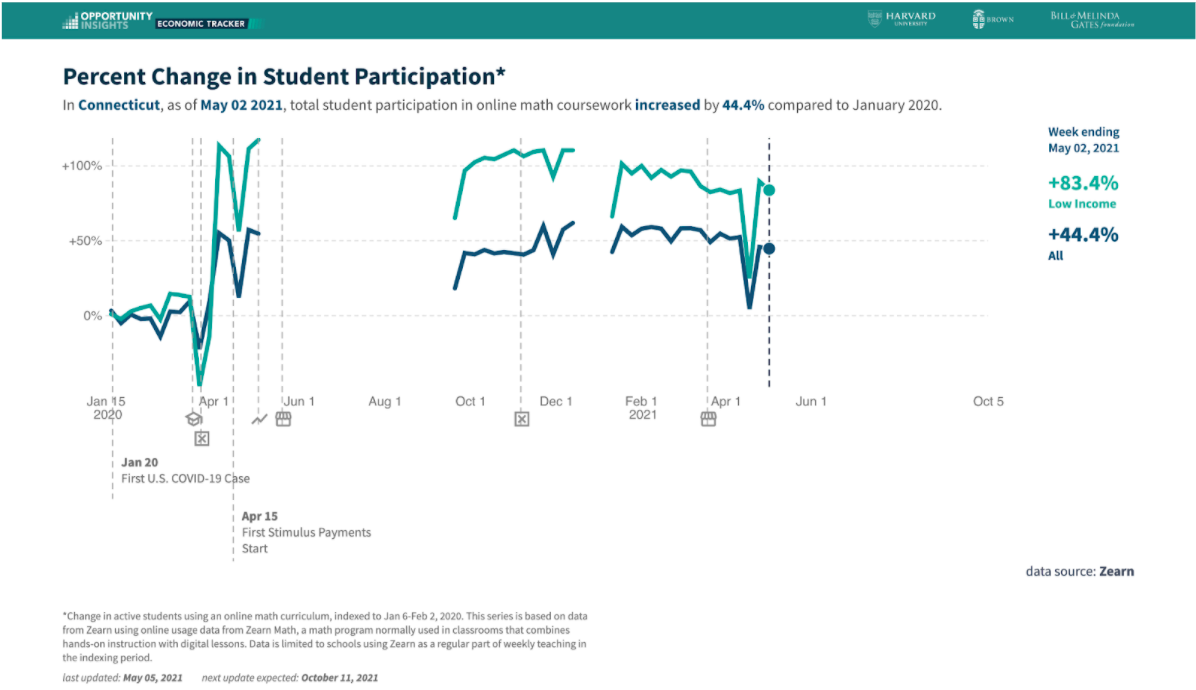Sharma: Acceleration vs. Remediation, Closing the Achievement Gap, Keeping Academic Growth Going — Insights from Math Learning in the Pandemic

Get stories like this delivered straight to your inbox. Sign up for The 74 Newsletter
The pandemic has been devastating for students and families on so many levels. It also produced insights that constitute urgent news for schools, both as they contend with the next wave of coronavirus and in the longer-term future.
Today, a quarter of elementary school students in the U.S. use the Zearn platform and they have completed more than 7.5 billion math problems since Zearn’s launch in 2016. In the course of doing so, they have allowed us to see patterns that we believe can help get kids’ learning back on track. Here are three:
1 School closures are undeniably tough on student learning, especially for students in low-income households. But there are steps states and districts can take to prevent interruptions to learning.
Before the pandemic, there was no gap in participation on our platform between children in low-income and high-income schools, but a massive gap emerged when schools closed. By the end of that school year, participation among kids in high-income areas had mostly recovered, but it was still down roughly 40 percent in low-income areas, which has massive implications for learning — students who aren’t participating in lessons aren’t learning and will need to both catch up and move forward in their future learning.
For much of the country, this alarming opportunity gap persists, yet some states and districts have been able to shrink or even eliminate it. Educators saw that students can’t learn when they can’t connect and treated that as a problem to solve. Keeping schools open whenever possible, distributing devices, expanding internet access and providing families with targeted logistical, technical and learning support —such as technological training so parents can help their children navigate online platforms and academic assistance for students learning remotely — can greatly increase student participation, particularly for low-income children.
Connecticut understood this from the outset, which is why the state was able to raise participation among students in low-income schools to nearly double the rate it was pre-pandemic. And Louisiana demonstrates that it’s never too late to change course. Three months into the pandemic, average student progress in the state, as measured by lessons students completed by demonstrating mastery, was down by more than 50 percent compared with the previous three months, and down nearly 70 percent for low-income students. When the state’s schools reopened for in-person learning, student participation on Zearn skyrocketed and Louisiana demonstrated a stronger recovery in the 2020-21 school year than any other state in the country.
2 Acceleration, not remediation, is key to getting kids back on track.
Many educators face the daunting task of helping students make up for multiple years of missed learning. Traditionally, this means revisiting the previous year’s content to ensure children understand more basic content before moving on. The problem with this approach is that teachers are likely to spend time on what students should have learned in earlier grades rather than on grade-level skills. It’s also not the most effective way to bring kids up to speed.
How do we know? Zearn’s recent research with TNTP analyzed more than 6,000 third-, fourth- and fifth-grade classrooms serving more than 50,000 students who missed an entire section of critical math content during the 2019-20 school year. About half the classrooms followed a traditional approach, starting with below-grade-content first, while the rest took a learning acceleration approach, starting with grade-level content and filling in below-grade-level gaps only as needed.
Students who experienced acceleration struggled less — answering more questions correctly — and were able to successfully complete 27 percent more grade-level lessons than those who started at the same level but received remedial lessons instead. This strategy is even more effective for students of color (49 percent more grade-level lessons than those receiving remediation) and students from low-income households (28 percent more grade-level lessons than those receiving remediation).
3 Consistent use of quality curricula can propel student learning.
American students’ math performance has long trailed that of children in many other countries, not because of a lack of resources, but because of a flawed approach. In the absence of a quality curriculum, math is often taught as a set of disconnected procedures that students often memorize, instead of a progression of interrelated, foundational concepts. Without a solid grounding in the hows and whys of math, students have difficulty putting it into practice to solve complex problems — and that difficulty breeds dislike. In the context of the pandemic, children are at even higher risk of missing out on key concepts , which could hinder their progress in math for years if left unaddressed.
It doesn’t have to be this way. High-quality curricula focus on sequentially moving through the big concepts and provide support as students need it to ensure they get to mastery — and an independent study of more than 800 schools and 100,000 students in Louisiana showed that this approach produced learning gains equivalent to an additional 1.5 months of instruction over the course of a school year, an effect that compounded over multiple years.
Similarly, in a separate analysis, students in schools with high Zearn usage in Louisiana showed 1.5 to 2.5 times higher growth than students in non-Zearn schools — and the gains were even larger for students in low-income schools and schools predominantly serving Black and Latino students.
For all the ways the pandemic disrupted learning, it also revealed important truths about how to get kids re-engaged and learning more effectively. The way back won’t be easy, but we know what it takes, and we can start today.
Shalinee Sharma is the CEO and co-founder of Zearn Math.
Get stories like these delivered straight to your inbox. Sign up for The 74 Newsletter

;)
